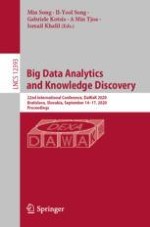2020 | Buch
Big Data Analytics and Knowledge Discovery
22nd International Conference, DaWaK 2020, Bratislava, Slovakia, September 14–17, 2020, Proceedings
herausgegeben von: Prof. Min Song, Prof. Il-Yeol Song, Gabriele Kotsis, Prof. Dr. A Min Tjoa, Ismail Khalil
Verlag: Springer International Publishing
Buchreihe : Lecture Notes in Computer Science
